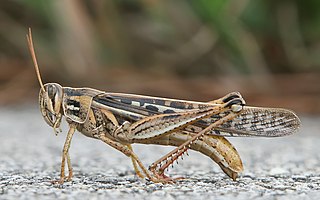
Grasshoppers are a group of insects belonging to the suborder Caelifera. They are amongst what are possibly the most ancient living groups of chewing herbivorous insects, dating back to the early Triassic around 250 million years ago.

The red locust is a large grasshopper species found in sub-Saharan Africa. Its name refers to the colour of its hind wings. It is sometimes called the criquet nomade in French, due to its nomadic movements in the dry season. When it forms swarms, it is described as a locust.
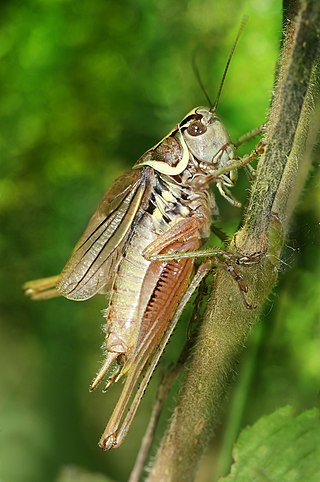
Roesel's bush-cricket, Roeseliana roeselii is a European bush-cricket, named after August Johann Rösel von Rosenhof, a German entomologist.
Chorthippus jutlandica, the Jutland bow-winged grasshopper, is a species of grasshopper in the subfamily Gomphocerinae. It is endemic to sparsely vegetated coastal sand dunes in an area covering only 87 km2 (34 sq mi) between Blåvandshuk and Hvide Sande in western Jutland, Denmark, but it is common and not considered to be under any threat.

Saga pedo is a species of wingless bush cricket from the southern half of Europe and western and central Asia. This brown or green bush cricket typically has a total length, from the head to the tip of the ovipositor, of up to 10.5 cm (4.1 in), but exceptionally it may reach 12 cm (4.7 in), which makes it one of the largest European insects and one of the world's largest Orthoptera. The head-and-body alone typically is 5–7 cm (2.0–2.8 in) long in adults, but may reach up to 7.8 cm (3.1 in).
Schayera baiulus is a species of grasshopper in the family of the Acrididae. The species is endemic to the Northern Region of Tasmania in Australia. The species is extremely rare and critically endangered, with only five confirmed specimens ever found.

The Senegalese grasshopper is a medium-sized grasshopper species found in the Sahel region of Africa, the Canary Islands, Cape Verde Islands, and West Asia. Although not called a locust in English, this species shows gregarious behaviour and some morphological change on crowding. In many parts of the Sahel, this species may cause greater year-on-year crop damage than better-known locusts, attacking crops such as the pearl millet.

Melanoplus bivittatus, the two-striped grasshopper, is a poikilothermic species of grasshopper belonging to the genus Melanoplus. It is commonly found in North America, with high quantities inhabiting Canadian prairies and farmland.
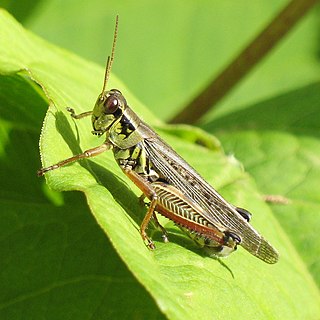
Melanoplus femurrubrum, the red-legged grasshopper, is a species of grasshopper belonging to the genus Melanoplus. It is one of the most common grasshoppers found in Mexico, the United States, and Canada. This grasshopper is frequently used as a model organism in scientific studies, due to their abundance throughout North America and behavioral response to changes in climate.

Sigaus robustus is a New Zealand species of grasshopper classified as Threatened: Nationally Endangered. It is restricted to open stony habitat of the Mackenzie Basin of the South Island. Although a grasshopper, it is a poor jumper, relying on camouflage to hide from predators. It is threatened by introduced mammals such as stoats, hedgehogs, and rats.

Taeniopoda eques, the western horse lubber grasshopper, is a relatively large grasshopper species of the family Romaleidae found in arid and semi-arid parts of southwestern United States to central and southwestern Mexico. Most populations are identifiable by their shiny black bodies with contrasting yellow markings, but some adults are mostly yellowish, orangish or greenish. The species is unique in using its black coloration to thermoregulate and in being chemically defended. The aposematic coloration warns vertebrate predators of its unpalatability and allows the grasshopper to roost conspicuously upon shrubs.
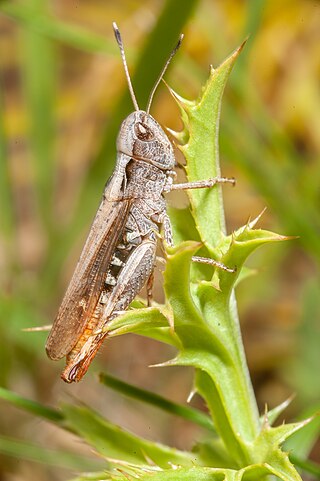
The rufous grasshopper is a species of grasshopper. It is a medium-sized, broad, brown, short-horned grasshopper with clubbed antennae that are tipped with a conspicuous white or pale colour. It is fairly large, averaging 14 to 22 mm in length. It is of the subfamily Gomphocerinae in the family Acrididae, the predominant family of grasshoppers. This species is present in most of Europe, in the eastern Palearctic realm, and in the Near East. It can be encountered from late July through mid-December, usually in dry or slightly moist habitats. The environments in which it typically resides include dry grassland on calcareous soils, sheltered valleys with scrub, and the open borders of forests. It feeds on grasses and various herbaceous plants. It is known for its distinctive courtship song and accompanying display.

Chorthippus albomarginatus, the lesser marsh grasshopper, is a common grasshopper of European grassland both damp-marshy and dry, including salt-marsh and coastal habitats.

Schistocerca americana is a species of grasshopper in the family Acrididae known commonly as the American grasshopper and American bird grasshopper. It is native to North America, where it occurs in the eastern United States, Mexico, and the Bahamas. Occasional, localized outbreaks of this grasshopper occur, and it is often referred to as a locust, though it lacks the true swarming form of its congener, the desert locust.
Cornops aquaticum is a semiaquatic species of grasshopper native to the Neotropics, from southern Mexico south to central Argentina and Uruguay. It feeds and breeds exclusively on members of the aquatic plant family Pontederiaceae, especially water hyacinth, and is being investigated as a possible biological pest control agent for the water hyacinth in countries where that plant is invasive.

Trimerotropis huroniana, known generally as the lake Huron locust or great lakes grasshopper, is a species of band-winged grasshopper in the family Acrididae. It is found in Wisconsin and Michigan in the United States, and Ontario in Canada.
Chorthippus bozdaghi, commonly known as the Bozdagh grasshopper, is a critically endangered species of grasshopper endemic to the Bozdağ Mountains of western Turkey.
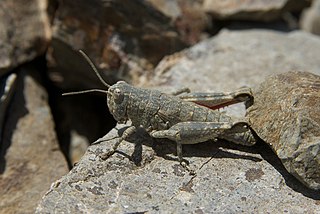
Sigaus nivalis, is an alpine short-horned grasshopper, endemic to the South Island of New Zealand. Sigaus nivalis is brachypterous and flightless, therefore they travel by hopping. They bask during the day so need open habitat.

Cyrtacanthacris aeruginosa or simply green tree locust is a large species of grasshopper that can be found in the grasslands of Africa. They pertain to the genus Cyrtacanthacris and are composed by three subspecies, C. a. aeruginosa, C. a. flavescens and C. a. goldingi, all three of them descend from a unique ancestor. The specie is univoltine, that is, it only produces one brood of offspring per year, furthermore it also experiences egg diapause, meaning that the eggs have a phase of suspended or arrested growth. In terms of overwintering strategy, Aeruginosa adults mate and then the female lay the eggs and die before the dry season, the eggs stay in diapause for 7 months and take 45–67 days to incubate.
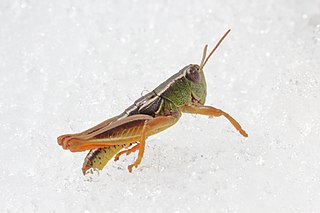
Sigaus nitidus is a species of short-horned grasshopper in the family Acrididae, endemic to New Zealand. This alpine grasshopper species is flightless and silent.

















